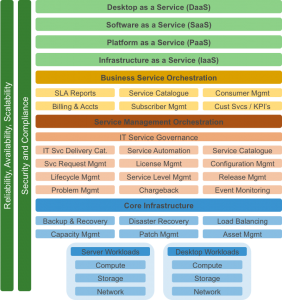 Cloud computing is a way to use (and also deliver) computing resources (for a formal definition see The NIST Definition of Cloud Computing).
Cloud computing is a way to use (and also deliver) computing resources (for a formal definition see The NIST Definition of Cloud Computing).
For this reason there are different types of cloud based on which type of “computing” resources are provided. Mainly there are three big silos:
-
Infrastructure as a service (IaaS): usually it provides VMs a virtual datacenters resources (like storage and networking), and also the infrastucture need to manage them. An example of this kind of cloud is Amazon EC2.
-
Platform as a service (PaaS): in this case a developer platform is provided that usually include OS, libraries, programming language execution environment, and all that could be useful to provide multi-tiers application (included usually database, presentations servers, …). An example of this kind of cloud is Microsoft Azure.
-
Software as a service (SaaS): in the case a single application or service is provided (or a set of them). An example of this kind of cloud is Microsoft Office 365 or Google Apps.
But a lot of other types could be defined as also the entire stack could be provided using a All as a Service (XaaS), or better an IT as a Service (ITaaS) approach.
 Those different clouds imply a different management responsibility between the cloud user and the cloud provider:
Those different clouds imply a different management responsibility between the cloud user and the cloud provider:
- in traditional IT all must be managed by the IT staff
- in IaaS only the level from the OS (except some configuration task at the virtualization level)
- in PaaS from the data level (except some configuration task at runtime and/or middleware level)
- is SaaS usually there are only the task related to provisioning and configuration of the application/services, but not the maintenance of them
Of course it must be consider also the effort for the migration to a cloud approach.
 But there could be also a cloud classification on how you access your resources:
But there could be also a cloud classification on how you access your resources:
- Private Cloud: resources are internally
- Public Cloud: resources are externally
- Hybrid Cloud: resources are part internally and part externally
Of course in the private cloud the provider and the user of the cloud could be the same organization, so part of the management considerations may be revisited.












